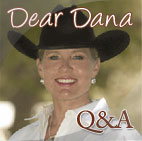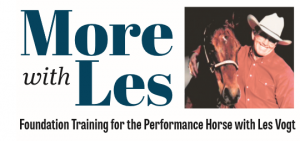 Since in last lesson’s exercises we asked you to be conscious of the horse’s nose getting too far out in a turn, this exercise shouldn’t be new to you. But before, you only used the outside rein to correct problems; here I want you to use the outside rein consciously, as you ask the horse to really break at the poll and bring his nose toward his chest from the lateral flexion position.
Since in last lesson’s exercises we asked you to be conscious of the horse’s nose getting too far out in a turn, this exercise shouldn’t be new to you. But before, you only used the outside rein to correct problems; here I want you to use the outside rein consciously, as you ask the horse to really break at the poll and bring his nose toward his chest from the lateral flexion position.
Begin by walking a circle to the right, with light rein contact and your horse’s frame matching the circumference of the circle, just like you did in the last lesson. Now make contact with your left rein and very gently, with just your fingertips, work your hands back and forth until your horse softens his neck and starts to bring his nose in toward his chest. While you’re moving the reins, you’ll want to gently squeeze with your calves to encourage him to keep moving up over the bit rather than slowing down. As soon as your horse softens to your rein pressure and moves his nose in toward his chest, release your cues and reward him.
Vertical Flexion: On a Straight Line
31st in a series
 After a good overview of vertical flexion last issue, Les puts you and your horse on a straight line.
After a good overview of vertical flexion last issue, Les puts you and your horse on a straight line.
After you’ve been getting vertical flexion on the bend and at the standstill for a while, introduce vertical flexion on a straight line as you walk your horse forward. This is a critical part of your “feel” training, as you’ll be required to instantly adjust your pressure in one or both hands in order to teach your horse to maintain straight head-to-tail alignment while maintaining flexion at the poll.
Start by establishing light rein contact with both hands while you’re riding at the walk in a straight line. Keeping that light feel, gradually squeeze your calves just behind the cinch (or bump if you need to), driving your horse forward into the bit as you softly start to work the bit back and forth with your fingertips, encouraging him to relax his poll and drop his head.
More on Vertical Flexion
30th in a series
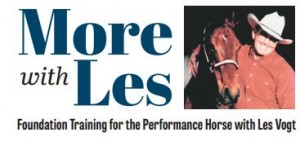 Last issue, Les covered the “nuts and bolts” of vertical flexion. Now, let’s take an overview.
Last issue, Les covered the “nuts and bolts” of vertical flexion. Now, let’s take an overview.
It’s important not to ask for too much from your horse at once. You don’t have to get the total result from your horse right from the start, but you do want the thought—the gesture—that he is willing to think about giving his nose to the pressure on the rein. When you first ask, your horse could give you a real negative gesture by lifting his neck when he feels the rein—let’s hope not! But a positive gesture would be him thinking, just thinking, about dropping his nose and rounding his neck when he feels you pick up. Always give him a big “atta boy” for positive gestures.
Vertical flexion: 1 component of collection
29th in a series
 We say a horse is “soft in the bridle” when he has achieved soft vertical flexion – that is, when the horse will drop his nose by rounding his neck and poll whenever he feels light contact with both reins. Your ultimate goal is to get this reaction from your horse before you’ve even taken all the slack out of your reins—like you could ride with silk threads and not break them—wouldn’t that be great! We all dream about it!
We say a horse is “soft in the bridle” when he has achieved soft vertical flexion – that is, when the horse will drop his nose by rounding his neck and poll whenever he feels light contact with both reins. Your ultimate goal is to get this reaction from your horse before you’ve even taken all the slack out of your reins—like you could ride with silk threads and not break them—wouldn’t that be great! We all dream about it!
But I’ll warn you right now, it won’t happen if you’re still feeling any resistance when you ask for lateral flexion. If you are still getting resistance to either side, you need to keep working that before you start into asking for much flexion vertically. If you ask too soon, you’re likely to create a dull mouth in your horse rather than the soft, responsive one that you’re after. Each step builds upon the one before it, and getting each step perfect, before you move on to the next one, is critical.
Vertical flexion: Giving at the poll
28th in a series
Last issue, Les wrapped up lateral flexion with some details on steering. Now he takes us into vertical flexion—an important component of stops, circles…and much more.
Objective
To begin to get your horse to give at the poll as a result of soft pressure on his mouth with both reins
Skills You Will Develop
Timing: Timing is critical in this stage of the program. You want to make sure that you reward your horse instantly when you get the result you want so he learns to give and not pull.
More on turns: Important details
27th in a series
After using pattern exercises the last two issues, Les wraps up his lesson with some key points. Who’s steering anyway? A very simple concept that can be easy to forget is this: If you’re not telling your horse to turn, he should be going straight. Too many riders let the arena fence do their steering for them, and when they come off it they, and the horse, can really get lost. So get off the rail, look up, then pick a point and trot toward it. What happens? Odds are your horse will start drifting toward what interests him, and you get an excellent training opportunity for him and yourself!
How fast can you reward your horse?
24th in a Series
Last issue, Les discussed some methods to deal with pressure and communication. Now let’s look in detail at the process.
The better you get at rewarding your horse for the correct response or even the correct thought, the faster he is going to progress through this program. 
This means that before he can be trained, you need to become trained. You need to get to the point where your hands respond to the presence and absence of resistance in your horse’s mouth, almost before your brain comprehends it. Think for a minute about when you drive a car (or, for our younger readers, ride a bicycle). When you come to a curve in the road, do you mentally stop and think about how you’re going to make it around the corner before you actually start to move the wheel? Probably not if you’ve been driving for more than a few months. Your riding has to start to become the same way:
Hanging Bridle: A good exercise
Fourteenth in a series In recent issues, Les covered cuing zones and other details of using our legs. Here is an exercise that illustrates with our hands.
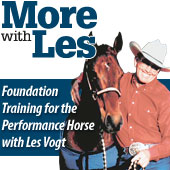 Here’s a good exercise to remind you of how little rein pressure it takes to send a signal to your horse. To try it, just hang your bridle on a doorknob, like it would hang from a horse’s head. Now stand about five feet away, take one rein in your hand and just lift it until you make contact with the bit and it starts to move. You’ll see that it doesn’t really take a lot of pressure or movement on your part to get movement out of the bit. Our goal is not to force the horse’s movement through the bridle, but to teach him to respond in a certain way when he feels contact, not necessarily pressure, from the bit. The faster you can train yourself to cue him with a lighter touch, the faster you will get the light response we all want to achieve.
Here’s a good exercise to remind you of how little rein pressure it takes to send a signal to your horse. To try it, just hang your bridle on a doorknob, like it would hang from a horse’s head. Now stand about five feet away, take one rein in your hand and just lift it until you make contact with the bit and it starts to move. You’ll see that it doesn’t really take a lot of pressure or movement on your part to get movement out of the bit. Our goal is not to force the horse’s movement through the bridle, but to teach him to respond in a certain way when he feels contact, not necessarily pressure, from the bit. The faster you can train yourself to cue him with a lighter touch, the faster you will get the light response we all want to achieve.
Pick up the RPMs: The ancient art of clucking
 Tenth in a series
Tenth in a series
Now that Les has covered the importance of our hands in the last two issues, let’s learn another communication device.
Clucking is a conditioned response. I read somewhere that clucking goes back to Xenophon*, who lived in something like 400 B.C. Anyway, horsemen have been doing it a long time. And it is interesting how clucking makes a difference, as far as bringing up the adrenaline in a horse.
Training Your Hands: Part 2
 Ninth in a series
Ninth in a series
Last issue, Les started an in-depth look at how to use our hands. We pick up with more keys to communication.
Another thing you’ll need to work on is to develop your hands’ “neutral” position, which needs to become one where there is no contact with the bit. Our goal is to have a horse that yields quickly and smoothly to any pressure—ideally to just the feel of you taking the slack out of the reins—and if you’re used to having contact with the bit all the time, you’ll never get there.


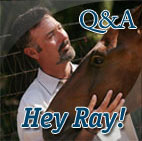
 Read Columns
Read Columns
